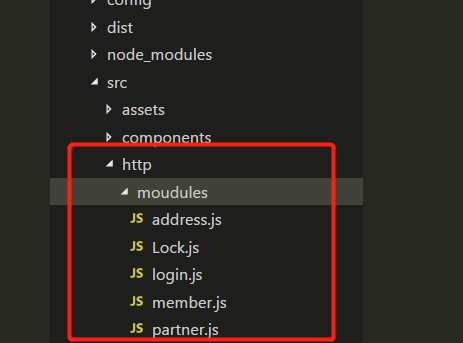在vue开发中,会涉及到很多接口的处理,当项目足够大时,就需要定义规范统一的接口,如何定义呢?
本文使用vue-cli生成的项目举例。
第一步.在src目录下新建一个文件夹http,在http目录下建文件夹moudules,后台提供的所有接口都在这里定义.
第二步.在moudules目录下划分模块新建js文件,比如:
a.会员中心模块: member.js
b.登录注册模块: login.js
c.合伙人模块: partner.js
目录大概是这个样子:

第三步,需要引入axios做相应的配置。
1.首先安装axios
npm install axios
2.在http目录下新建axios.js:
/* jshint esversion: 6 */
import axios from 'axios';
import Cookies from "js-cookie";
import config from './config';
import router from '@/router';
import { Toast} from 'vant';
export default function $axios(options) {
return new Promise((resolve, reject) => {
const instance = axios.create({
baseURL: config.baseUrl,
headers: config.headers,
timeout: config.timeout,
withCredentials: config.withCredentials,
});
// request 拦截器
instance.interceptors.request.use(
config => {
//在发送之前做点什么
let auth_token = Cookies.get('auth_token');
if (auth_token) {
config.headers.auth_token = auth_token;
} else {
let loginpage = Cookies.get('loginpage');
if (loginpage) {
router.push('/login');
}
}
if (config.method === 'post') {}
return config;
},
error => {
// 判断请求超时
if (error.code === 'ECONNABORTED' && error.message.indexOf('timeout') !== -1) {
Toast("信号不好,请求超时")
}
}
);
// response 拦截器
instance.interceptors.response.use(
response => {
//对响应数据做点什么
let data;
if (response.data == undefined) {
data = JSON.parse(response.request.responseText);
} else {
data = response.data;
}
return data;
},
err => {
if (err && err.response) {
console.log(err)
}// 返回接口返回的错误信息
return Promise.reject(err);
}
);
// 请求处理
instance(options).then(res => {
resolve(res);
return false;
}).catch(error => {
reject(error);
});
});
}
3.在http目录下新建config.js:
export default {
method: 'get',
// 基础url前缀
baseUrl: baseUrl,//请求的域名地址
// 请求头信息
headers: {
'Content-Type': 'application/json;charset=UTF-8'
},
// 参数
data: {},
// 设置超时时间
timeout: 10000,
// 携带凭证
withCredentials: false,
// 返回数据类型
responseType: 'json'
}
第四步,在http下面的js文件中引入api.js导出的函数,拿其中一个文件login.js说明:
1.api.js:
/* jshint esversion: 6 */
import * as login from './moudules/login';
// 默认导出
export default {
login,
}
2.login.js
import axios from '../axios'
/*
* 系统登录模块
*/
// 登录
export const login = (data) => {
return axios({
url: '/app/api/v1/user/phonelogin',
method: 'post',
data
});
};
第五步:将api挂载在 Vue 原型的 $api 对象上
1.在http文件下新建index.js文件:
import api from './api';
const install = Vue => {
if (install.installed)
return;
install.installed = true;
Object.defineProperties(Vue.prototype, {
// 注意,此处挂载在 Vue 原型的 $api 对象上
$api: {
get() {
return api
}
}
});
};
export default install
2.在项目的main.js文件下导入api:
import api from './http';
Vue.use(api);
第六步步,在组件中使用接口,比如在登陆页面中使用login的接口:
let loginInfo = {
phone: this.field.phone,
code: this.field.sms,
cityname: this.field.city
};
this.$api.login.login(loginInfo).then(res => {
if (res.ret == 0) {
Cookies.set("auth_token", res.data.authToken);
this.$toast.success({message:"登录成功",duration:2000});
setTimeout(() => {
this.loading = false;
this.$router.go(-1);
}, 2000);
}
})
最终http目录为:

以上方法定义接口虽然看起来麻烦点,但有却有其好处:
-
代码看起来规范,所有的接口都在一个文件夹定义,不用分散的各个组件,方便维护管理。
-
可以做到接口一次定义,多处使用。